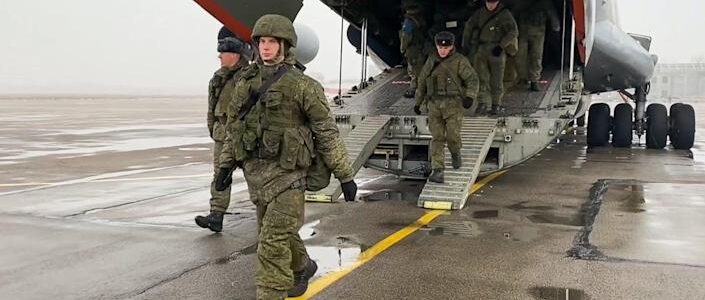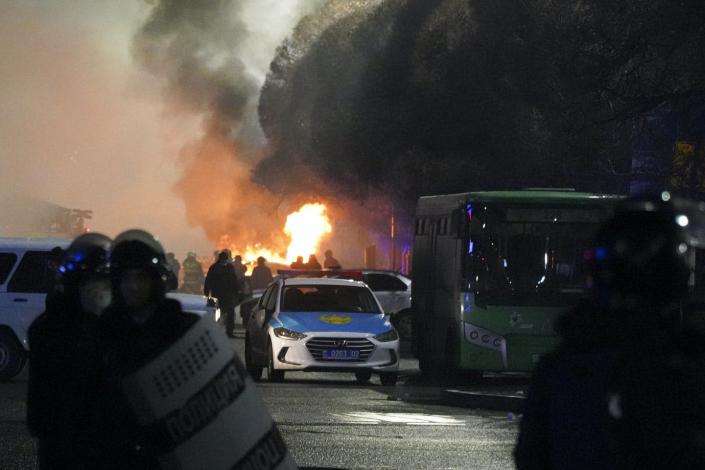
Add Kazakhstan to the list of former Soviet republics whose independence is now being threatened by Russia. Russian leader Vladimir Putin is using a similar playbook in Kazakhstan to one that he has used over almost a decade to threaten the sovereignty of Ukraine.
What began as protests over rising fuel prices on Jan. 2, 2021, quickly escalated into violent clashes on the streets of Kazakhstan. On Jan. 5, Kazakhstan President Kassym-Jomart Tokayev, a firm ally of Putin’s, requested support from the Collective Security Treaty Organization, of which Putin’s Russian Federation is the leading member. Russia has responded decisively by sending paratroopers, special operations troops and equipment as part of a nearly 3,000-strong force to Kazakhstan.

Tokayev explained his request by claiming that protesters are really “a band of terrorists” trained abroad. On Jan. 7, Tokayev escalated the conflict: “I have given the order to law enforcement and the army to shoot to kill without warning,” Tokayev said.
As a scholar of post-Soviet Ukraine, Russia’s involvement in Kazakhstan looks very familiar to me. It’s similar to what happened in Ukraine beginning in 2014, when peaceful protesters were met with violence by the government and a protest grew into a revolution that ultimately overthrew the Russian-backed leadership of the country.


Dangerous neighborhood
Seizing on that moment of domestic unrest in 2014, Putin gave direct orders to annex Crimea, a Ukrainian territory home to a key Russian naval base. Shortly afterward, he supported a war mounted by so-called Russian-speaking separatists in Ukraine’s eastern regions.
For more than eight years now, the Russian Federation has continued to support that conflict in Ukraine and has recently threatened Ukraine with a full invasion. This most recent version of Putin’s aggression toward Ukraine came in November 2021, when he staged 175,000 troops along the Ukraine border. His goal: to use a potential invasion as leverage to stop Ukraine from joining the alliance of Western countries known as NATO.
In Kazakhstan, as in Ukraine in 2014, the Russian government explains its military presence as appropriate and requested by a legitimate government. As in Ukraine, the Russian government emphasizes that external forces are responsible for unrest in the former Soviet republic. As in Ukraine, the Russian Federation has pointed out the need to protect a Russian-speaking population.
These tendencies of the Russian government to assert dominion over former territories that it lost during the breakup of the Soviet empire demonstrate that Russia is willing to act quickly and do anything to keep control of its neighborhood. I see this as an important message about what the Western leaders can expect from a meeting with Russian officials in Geneva on Jan. 10 to discuss the conflict building again along Ukraine’s border and Russia’s demands that NATO not expand to Ukraine.
Soviet and Russian legacies
Russia has long seen Kazakhstan as within its sphere of influence. In a press conference on Dec. 23, 2021, Putin called Kazakhstan a “Russian-speaking country in every sense of the word.”
Earlier Putin claimed that before the collapse of the Soviet Union, “Kazakhs never had a state of their own.” In December 2020, two members of Russia’s parliament claimed that territories of northern Kazakhstan were “a big gift” from Russia to Kazakhstan.
Such claims are reminiscent of the language that Putin has applied to Ukraine. He has often claimed that Ukraine was not a real country, including in an article published by the Kremlin in July 2021, in which he claimed that “modern Ukraine is entirely the product of the Soviet era.”
The use of the same terminology does not bode well for Kazakhstan.
Putin’s references to a Russian-speaking population in Kazakhstan are reminiscent of the experience of Ukraine’s Crimea region. In April 2014, Russian soldiers appeared on the streets of Crimea, forced Ukrainian soldiers to leave their posts, and oversaw a so-called referendum that allowed for Crimea to be integrated into the Russian Federation. The Russian Federation said then, and continues to claim, that its interest in Ukraine is a continued concern for the welfare of the Russian speakers in Ukraine, which in Russia’s view is being oppressed.
Controversial Russian politician Vladimir Zhirinovski claimed on Jan. 6, 2021, that Russian speakers in Kazakhstan are similarly oppressed by Kazakh language requirements. Zhirinovski is a radical figure in Russian politics, but it is usually assumed that he voices the more extreme claims of the Russian government.

Protecting from foreign invaders
Kazakhstan’s President Tokayev claimed that the protests in his country were fueled by the “free press” and foreign forces who were sponsoring terrorist activity in his country. The Russian government willingly accepted this terminology. Tokayev did not specify which external forces he meant.
Putin has long claimed that the Revolution of Dignity in Ukraine in 2014, which ousted his ally, President Viktor Yanukovich, was really a coup sponsored and coordinated by the U.S.
Similar arguments about outside influences were made by the embattled Belarusian dictator, Alexander Lukashenko, about the anti-government protesters in Russia-aligned Belarus in 2020.
The spokesperson for the Russia Foreign Ministry, Maria Zakharova, said on Jan. 6 that there is a need to stop extremism in Kazakhstan. Her words came in response to European Union foreign policy chief Josep Borrell’s concerns over the Russian troop deployment.
This consistent message supports Putin’s narrative about the need to protect Russia and the countries in its neighborhood against what he regards as destabilizing influences like the U.S. and NATO, which, according to Putin, support and promote anti-government extremists and revolutions in the region.

Show of strength
Putin continues to cultivate an image as a decisive leader who responded to a call from a neighboring country to “help Kazakhstan overcome this terrorist threat.”
His actions in Kazakhstan, I believe, are aimed at both internal and foreign audiences.
Domestically, Russian media see Russian troops as a part of a multilateral peacekeeping response, which includes troops from Belarus and Armenia. Deployment of so-called peacekeeping forces in Kazakhstan in the middle of instability and violence will be portrayed in Russia as a huge achievement for Putin.
This is also a message to Ukraine and the West. Putin will not hesitate to show strength to achieve Russia’s goals. Russia now has nearly 100,000 troops along the Ukrainian border. And while there was a reported withdrawal of 10,000 soldiers in late December in a de-escalation effort, most of the troops and military equipment remain.
Geneva outlook
Negotiations in diplomacy require compromise. However, Russia is entering the talks in Geneva with an ultimatum toward NATO and the U.S.
Russia’s demands, according to Reuters, include a “halt to NATO enlargement, no deployment of its weapons systems in Ukraine and an end to “provocative” military exercises” in the region.
Russian action in Kazakhstan should serve as a sobering reminder to Western countries that Russia is willing to act decisively to protect its interests and retain its influence in the neighboring countries.
Credit: Yahoo News
